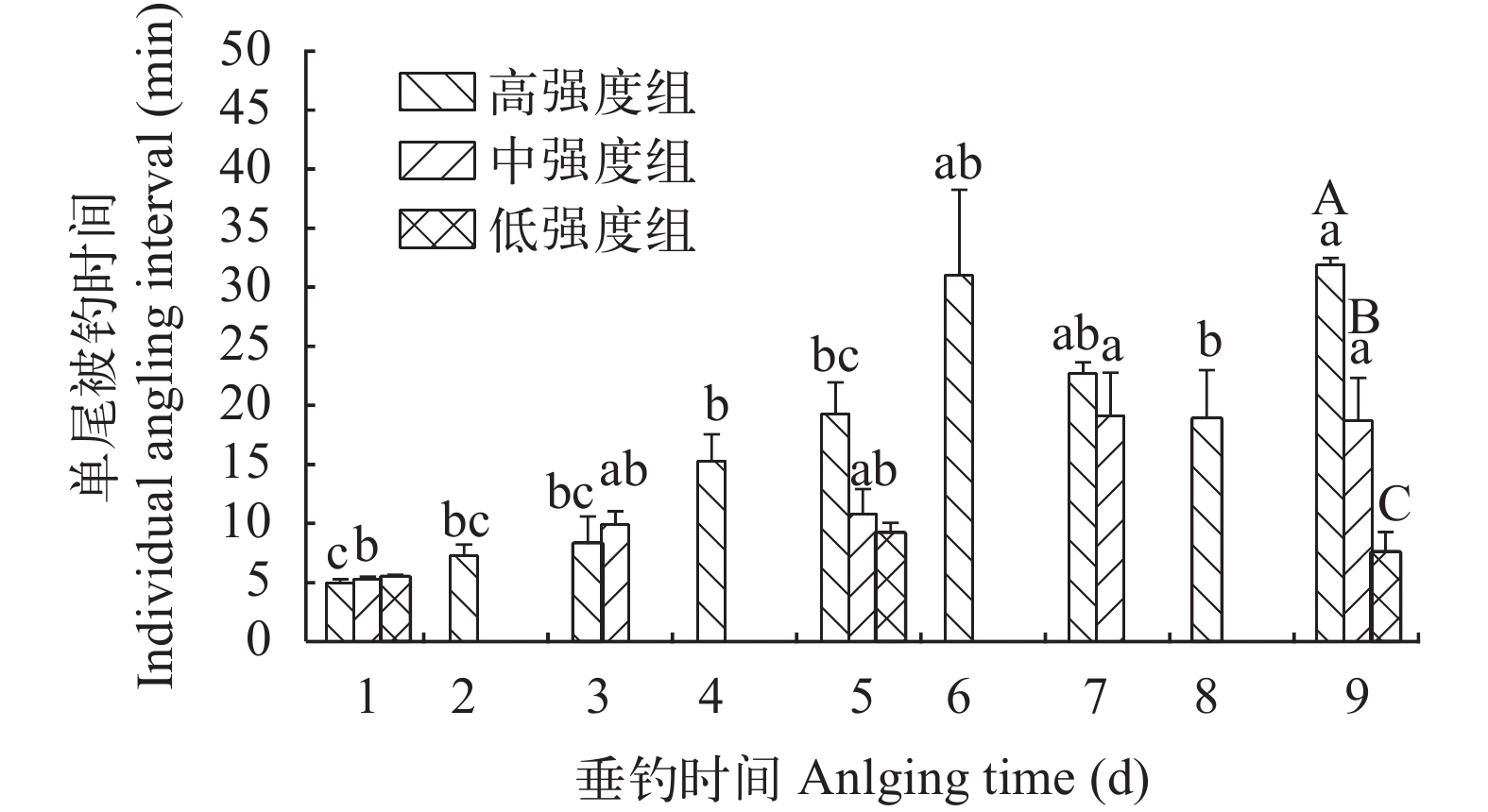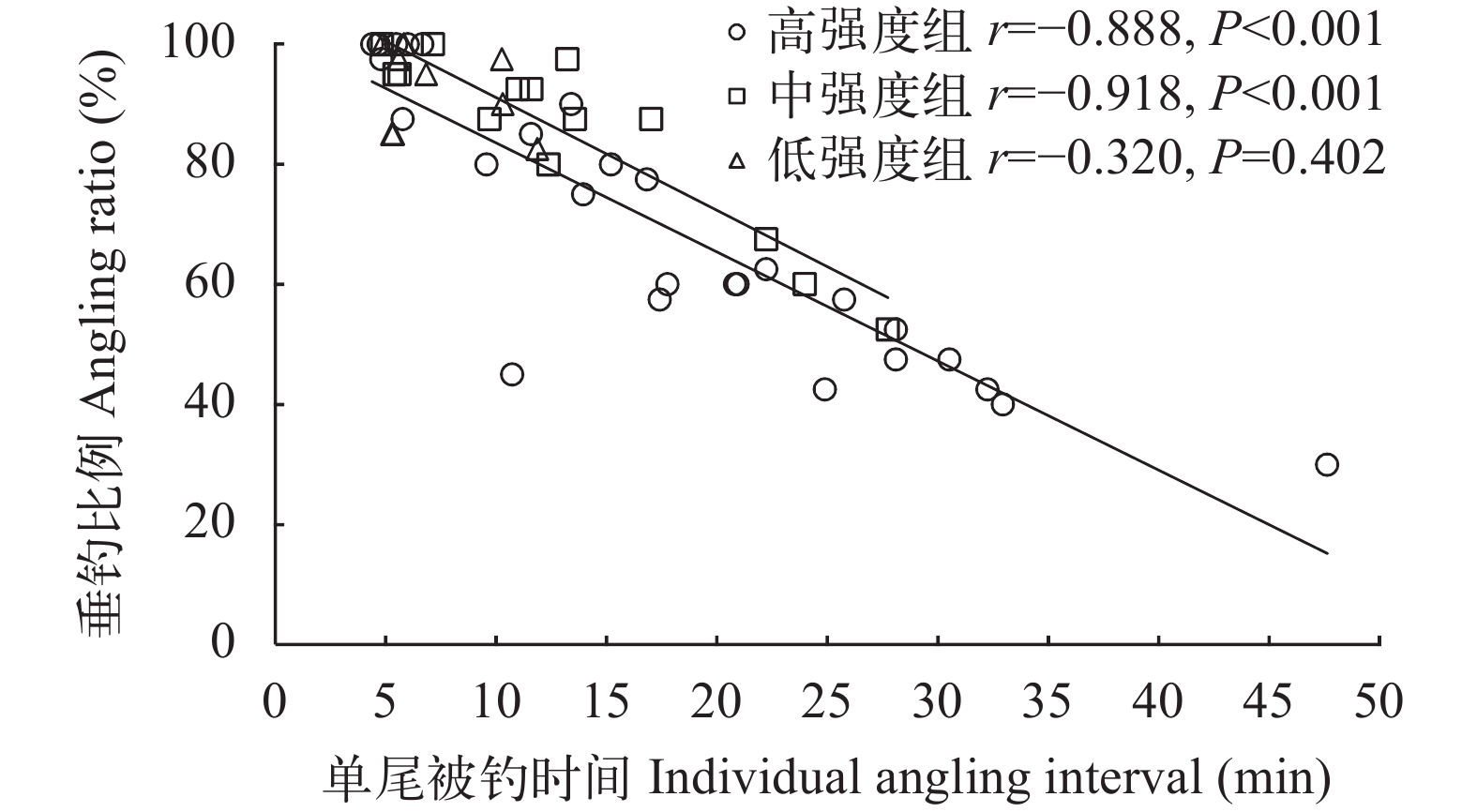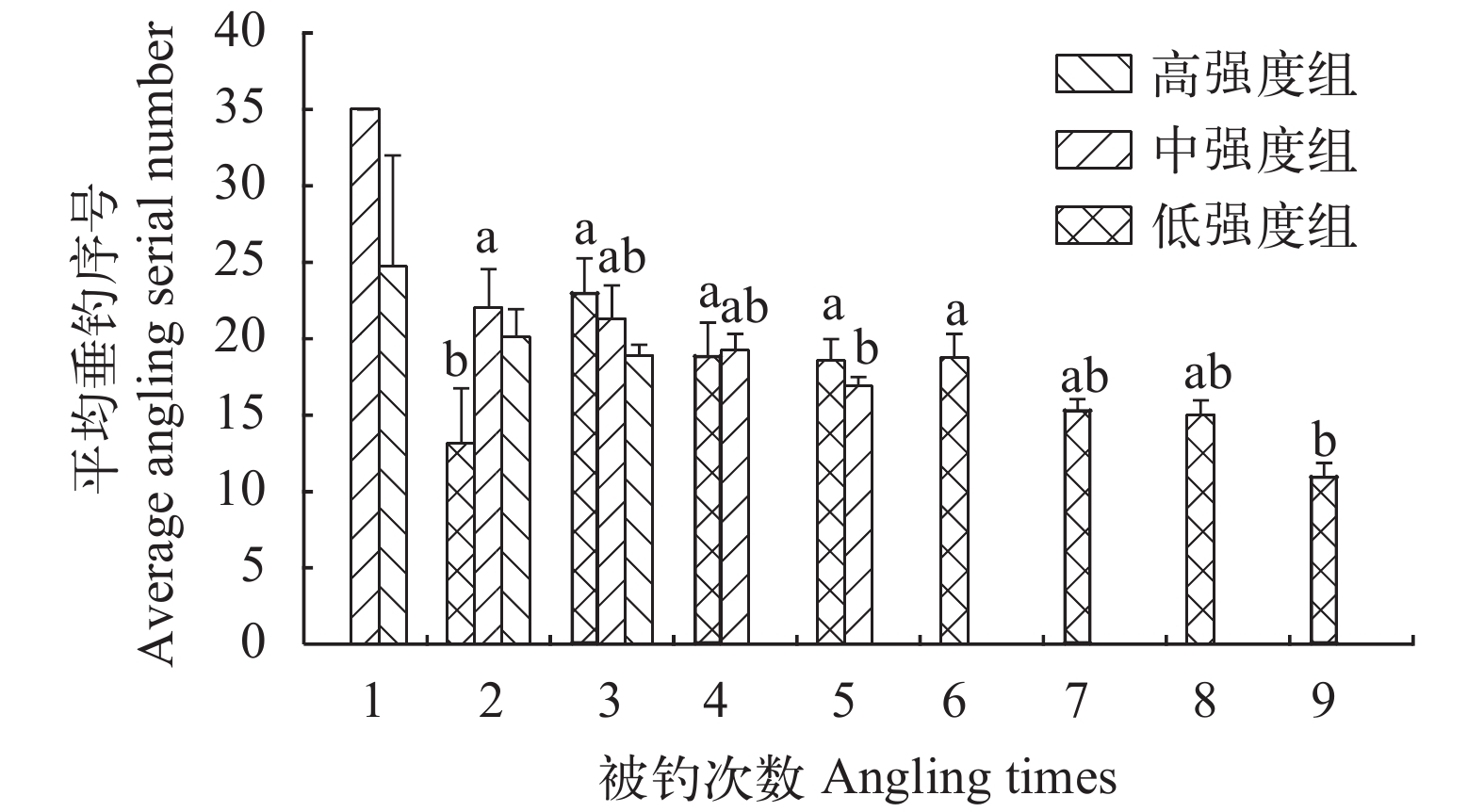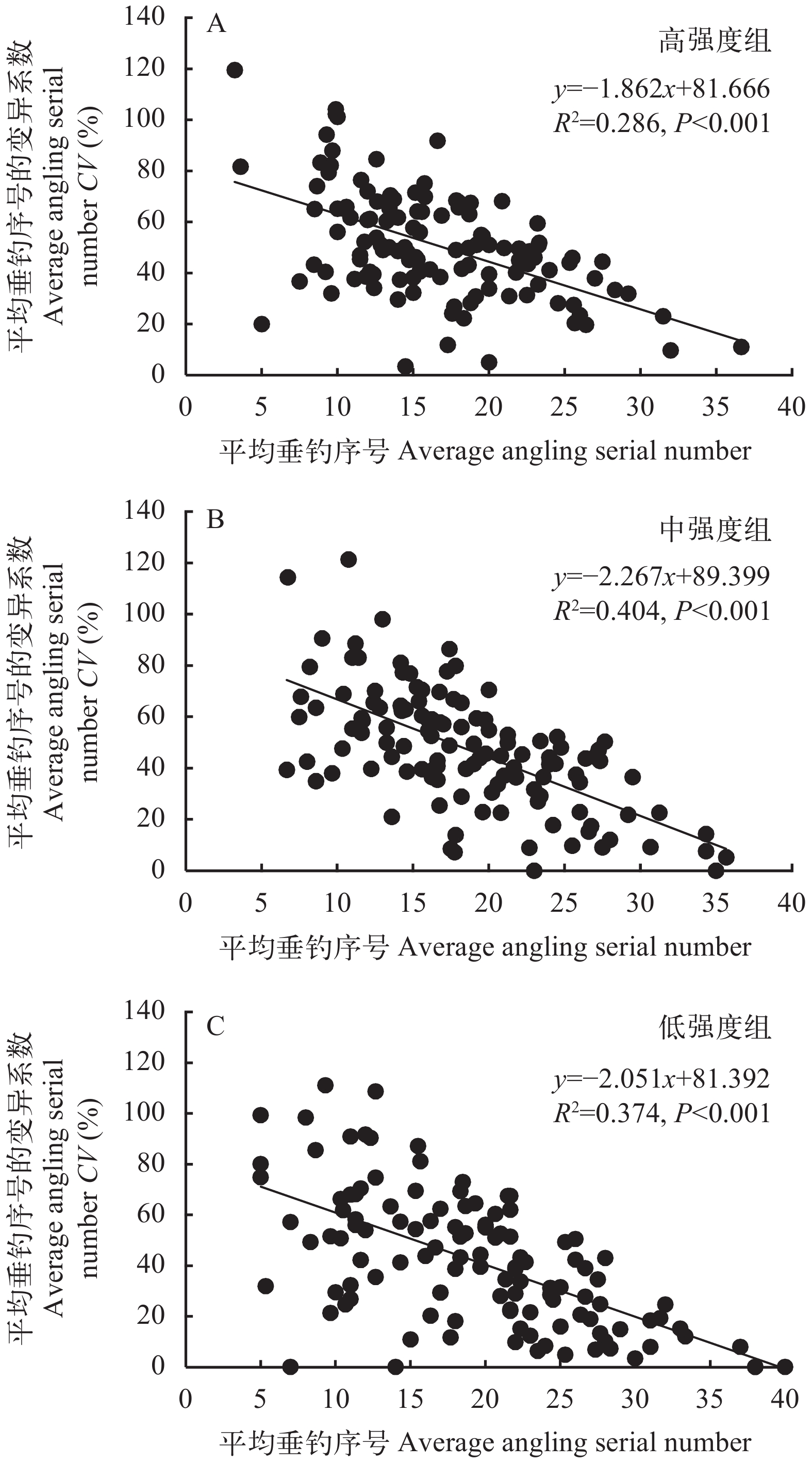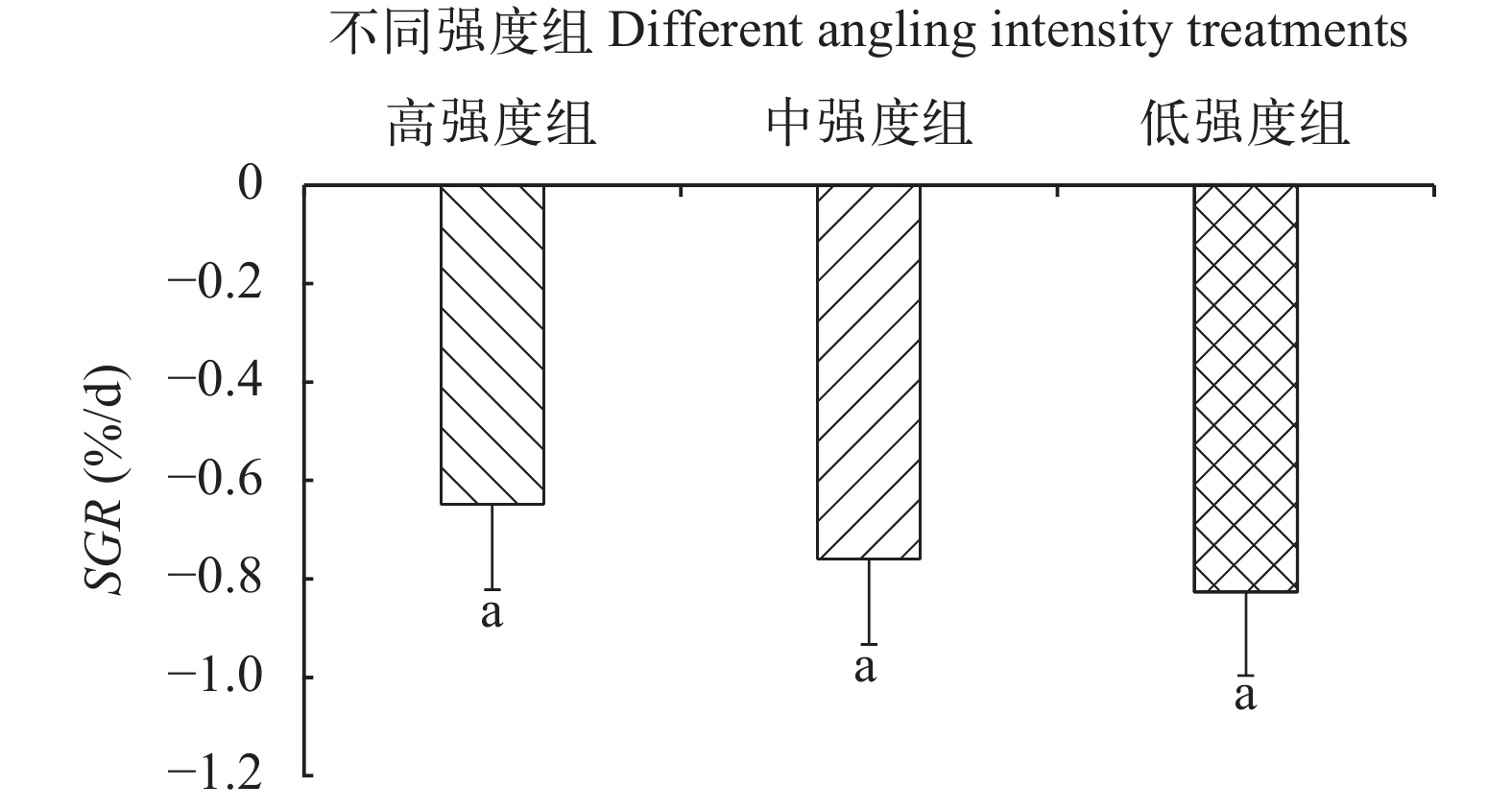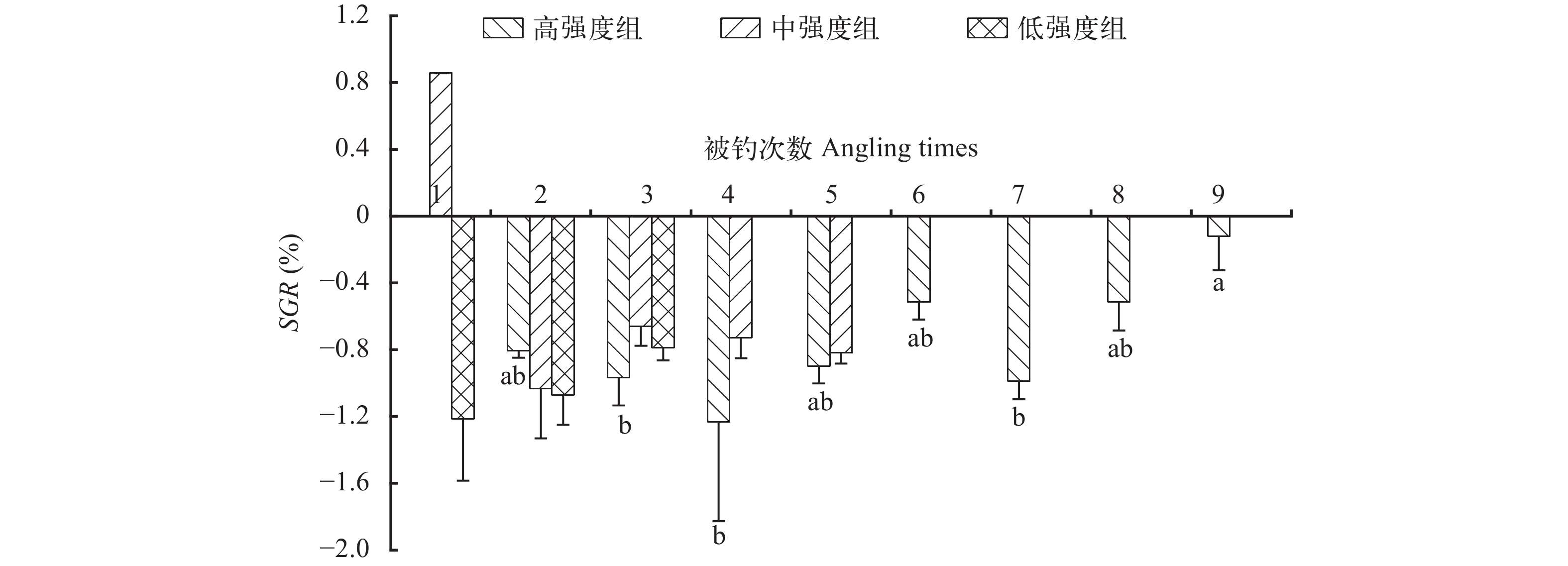EFFECT OF ANGLING INTENSITY ON THE VULNERABILITY TO ANGLING AND GROWTH OF JUVENILE CRUCIAN CARP
-
摘要: 为考察不同垂钓强度对鲤科鱼类易钓性和生长的影响, 研究以鲫(Carassius auratus)幼鱼为实验对象, 在实验(26.9±0.1)℃条件下对大小相近和机体健康的3个处理组[高强度组(1d垂钓1次)、中强度组(2d垂钓1次)和低强度组(4d垂钓1次)]进行垂钓实验; 每个垂钓处理组均设3个平行组, 每个平行组包括40尾鱼, 每个组在垂钓10h后则停止该组的垂钓活动, 记录成功垂钓每尾鱼的时间、序号和电子标签信息, 计算垂钓比例、单尾被钓时间、平均垂钓序号、变异系数和实验期间(9d)的生长率。研究发现: 3个垂钓强度组的垂钓比例均随着垂钓次数的增加而呈现下降的变化趋势, 单尾被钓时间呈现增加的变化趋势, 导致垂钓比例与单尾被钓时间呈负相关。除低强度组外, 高、中垂钓强度组的平均垂钓序号随着被钓次数的增加均呈现减小的变化趋势, 并且该2个强度组平均垂钓序号的变异系数随着被钓次数的增多均呈增大的变化趋势; 3个垂钓强度组的平均垂钓序号与其变异系数呈负相关。3个垂钓强度组在实验期间的特定生长率均出现负值情况, 但3个组之间无差异。研究表明: 高强度的垂钓活动会降低鲫幼鱼的易钓性, 并且导致个体生长表现出一定的负面效应, 表明高强度垂钓活动可能影响鱼类野外种群易钓性及其相关的其他表型的进化轨迹。Abstract: The vulnerability to angling refers to the stable difference in the probability of being caught among individuals within a fish species, which is easy to be affected by various environmental factors. Fish in nature are affected by human angling activities, but the characteristics of the effects of different angling intensities on the vulnerability to angling and growth of the Cyprinidae fishes are not clear. In order to investigate the effects of different angling intensities on the vulnerability to angling and growth performance of the Cyprinidae fishes in the Yangtze River, the juvenile crucian carp (Carassius auratus) was used as the experimental object in this study under the condition of the laboratory (26.9±0.1)℃, angling with different intensities for three treatment groups that have similar size and physical fitness, three treatment groups [high frequency group (angling once a day), medium frequency group (angling once every two days) and low frequency group (angling once every four days)]; three parallel groups were set up in each angling treatment group, including 40 fishes in each parallel group. After 10 hours of angling in each repetition, the angling activities of the group were stopped. The angling time, angling serial number and electronic information of each fish successfully fished were recorded. The angling ratio, individual fish angling interval, average angling serial number and its coefficient variation as well as the specific growth rate of fish during the experimental period (9d) were all calculated. The results showed that the angling proportion of the three angling intensity groups decreased with the increase of angling times, and the individual angling interval showed an increasing trend with angling time increased, which results in a negative correlation between angling proportion and individual angling interval. Except for the low intensity treatment, the average angling serial number of both the high and medium angling intensity treatments showed a decreasing trend with the increase of the angling times, and the coefficient variation of the average angling serial number of the two intensity treatments increased with the increase of the angling times. The average angling serial number of the three treatment treatments was negatively correlated with its variation coefficient. The specific growth rates of the three angling intensity treatments were all negative during the experiment, but there was no significant difference among the three groups. Our results suggested that high intensity angling activities can reduce vulnerability to angling of the juvenile crucian carp, and it can lead to obvious negative angling effect of individual growth, which shows that high-intensity fishing activities may affect vulnerability to angling and evolutionary trajectory of other related phenotypes of the wild fish populations.
-
-
图 2 不同垂钓强度和不同垂钓时间下鲫幼鱼的垂钓比例
不同小写字母表示同一垂钓强度组中的数据间存在显著差异(P<0.05), 不同大写字母表示同一垂钓时间中的数据间存在显著差异(P<0.05); 下同
Figure 2. Angling ratio of the juvenile crucian carp under the conditions of different angling intensities and different angling times
Different lowercases indicate significant differences within the same angling intensity whereas different capital letters indicate significant differences within the same angling time (P<0.05). The same applies below
图 5 不同垂钓强度和不同垂钓时间下鲫幼鱼的平均垂钓序号
在中强度组中被钓1次鱼的数量仅为1尾, 无法参与组间显著性差异的比较, 故其上方无小写字母
Figure 5. Average angling serial number of the juvenile crucian carp under the conditions of different angling intensities and different angling times
Only one individual was successfully angled at one time in intermediate angling intensity treatment, so this fish was excluded from the comparison among different angling times
表 1 鲫幼鱼的形态学参数
Table 1 The morphology of juvenile crucian carp
处理组
Treatment样本量Number 体重Body mass (g) 体长Body length (cm) 肥满度Condition factor (g/cm3) 高垂钓强度High intensity n=120 6.57±0.17 6.43±0.05 2.41±0.02 中垂钓强度Intermediate intensity n=120 6.56±0.16 6.44±0.05 2.40±0.02 低垂钓强度Low intensity n=120 6.57±0.16 6.43±0.05 2.43±0.02 -
[1] Palkovacs E P, Kinnison M T, Correa C, et al. Fates beyond traits: ecological consequences of human-induced trait change [J]. Evolutionary Applications, 2012, 5(2): 183-191. doi: 10.1111/j.1752-4571.2011.00212.x
[2] Burton T, Killen S S, Armstrong J D, et al. What causes intraspecific variation in resting metabolic rate and what are its ecological consequences [J]? Proceedings of the Royal Society B-Biological Science, 2011, 278(1724): 3465-3473. doi: 10.1098/rspb.2011.1778
[3] Louison M J, Adhikari S, Stein J A, et al. Hormonal responsiveness to stress is negatively associated with vulnerability to angling capture in fish [J]. Journal of Experimental Biology, 2017, 220(14): 2529-2535. doi: 10.1242/jeb.150730
[4] Devine J A, Wright P J, Pardoe H E, et al. Comparing rates of contemporary evolution in life-history traits for exploited fish stocks [J]. Canadian Journal of Fisheries and Aquatic Sciences, 2012, 69(6): 1105-1120. doi: 10.1139/f2012-047
[5] Jorgensen C, Enberg K, Dunlop E S, et al. Ecology: managing evolving fish stocks [J]. Science, 2007, 318(5854): 1247-1248. doi: 10.1126/science.1148089
[6] Kuparinen A, Hutchings J A. Consequences of fisheries-induced evolution for population productivity and recovery potential [J]. Proceedings of the Royal Society B-Biological Science, 2012, 279(1738): 2571-2579. doi: 10.1098/rspb.2012.0120
[7] Kuparinen A, Merilä J. Detecting and managing fisheries-induced evolution [J]. Trends in Ecology and Evolution, 2007, 22(12): 652-659. doi: 10.1016/j.tree.2007.08.011
[8] Nusslé S, Bornand C N, Wedekind C. Fishery-induced selection on an Alpine whitefish: quantifying gentic and environmental effects on individual growth rate [J]. Evolutionary Applications, 2009, 2(2): 200-208. doi: 10.1111/j.1752-4571.2008.00054.x
[9] Kendall N W, Quinn T P. Length and age trends of chinook salmon in the Nushagak river, Alaska, related to commercial and recreational fishery selection and exploitation [J]. Transactions of the American Fisheries Society, 2011, 140(3): 611-622. doi: 10.1080/00028487.2011.585575
[10] Philipp D P, Cooke S J, Claussen J E, et al. Selection for vulnerability to angling in largemouth bass [J]. Transactions of the American Fisheries Society, 2009, 138(1): 189-199. doi: 10.1577/T06-243.1
[11] Cooke S J, Cowx I G. The role of recreational fishing in global fish crises [J]. BioScience, 2004, 54(9): 857-859. doi: 10.1641/0006-3568(2004)054[0857:TRORFI]2.0.CO;2
[12] Arlinghaus R, Cooke S J. Recreational Fisheries: Socioeconomic Importance, Conservation Issues and Management Challenges [M]. Recreational Hunting, Conservation and Rural Livelihoods: Science and Practice. Oxford: Wiley-Blackwell Scientific Publications, 2009: 39-57.
[13] Arlinghaus R, Mehner T, Cowx I G. Reconciling traditional inland fisheries management and sustainability in industrialized countries, with emphasis on Europe [J]. Fish and Fisheries, 2002, 3(4): 261-316. doi: 10.1046/j.1467-2979.2002.00102.x
[14] Coleman F C, Figueira W F, Ueland J S, et al. The impact of united states recreational fisheries on marine fish populations [J]. Science, 2004, 305(5692): 1958-1960. doi: 10.1126/science.1100397
[15] Technical guidelines for responsible recreational fisheries [EB]. Food and agriculture organization of the United Nations (FAO), 2012.
[16] Granek E F, Madin E M P, Brown M A, et al. Engaging recreational fishers in management and conservation: global case studies [J]. Conservation Biology, 2008, 22(5): 1125-1134. doi: 10.1111/j.1523-1739.2008.00977.x
[17] Post J R, Sullivan M, Cox S, et al. Canada’s recreational fisheries: the invisible collapse [J]? Fisheries, 2002, 27(1): 6-17. doi: 10.1577/1548-8446(2002)027<0006:CRF>2.0.CO;2
[18] 贺春艳. 休闲垂钓旅游行为分析——以湖南长沙、株洲两地休闲垂钓爱好者为例 [J]. 顺德职业技术学院学报, 2006, 4(2): 64-68. doi: 10.3969/j.issn.1672-6138.2006.02.017 He C Y. Analysis on the behaviour features of recreational fishing-case study of fishing fans in Changsha and Zhuzhou, Huan Province [J]. Journal of Shunde Polytechinc, 2006, 4(2): 64-68. doi: 10.3969/j.issn.1672-6138.2006.02.017
[19] Brown C, Laland K N. Social learning in fishes: a review [J]. Fish and Fisheries, 2003, 4(3): 280-288. doi: 10.1046/j.1467-2979.2003.00122.x
[20] Arai T, Tominaga O, Seikai T, et al. Observational learning improves predator avoidance in hatchery-reared Japanese flounder Paralichthys olivaceus juveniles [J]. Journal of Sea Research, 2007, 58(1): 59-64. doi: 10.1016/j.seares.2007.01.004
[21] Wallerius M L, Johnsson J I, Cooke S J, et al. Hook avoidance induced by private and social learning in common carp [J]. Transactions of the American Fisheries Society, 2020, 149(4): 498-511. doi: 10.1002/tafs.10246
[22] Mezzera M, Largiadèr C R. Evidence for selective angling of introduced trout and their hybrids in a stocked brown trout population [J]. Journal of Fish Biology, 2001, 59(2): 287-301. doi: 10.1111/j.1095-8649.2001.tb00130.x
[23] Uusi-Heikkilä S, Wolter C, Klefoth T, et al. A behavioral perspective on fishing-induced evolution [J]. Trends in Ecology and Evolution, 2008, 23(8): 419-421. doi: 10.1016/j.tree.2008.04.006
[24] Borcherding J, Magnhagen C. Food abundance affects both morphology and behaviour of juvenile perch [J]. Ecology of Freshwater Fish, 2008, 17(2): 207-218. doi: 10.1111/j.1600-0633.2007.00272.x
[25] Bean C W, Winfield I J. Habitat use and activity patterns of roach (Rutilus rutilus (L.)), rudd (Scardinius erythrophthalmus (L.)), perch (Perca fluviatilis L.) and pike (Esox lucius L.) in the laboratory: the role of predation threat and structural complexity [J]. Ecology of Freshwater Fish, 1995, 4(1): 37-46. doi: 10.1111/j.1600-0633.1995.tb00025.x
[26] Jacobsen L, Berg S, Broberg M, et al. Activity and food choice of piscivorous perch (Perca fluviatilis) in a eutrophic shallow lake: a radio-telemetry study [J]. Freshwater Biology, 2002, 47(12): 2370-2379. doi: 10.1046/j.1365-2427.2002.01005.x
[27] 杨亚, 吴朝伟, 付世建, 等. 鲫幼鱼易钓性与标准代谢及形态特征的关联 [J]. 重庆师范大学学报(自然科学版), 2017, 34(2): 26-31. Yang Y, Wu C W, Fu S J, et al. Correlation between angling vulnerability and standard metabolic rate, and morphology in juvenile crucian carp (Carassius auratus) [J]. Journal of Chongqing Normal University (
Natural Science ) , 2017, 34(2): 26-31. [28] 杨亚, 付世建, 彭姜岚, 等. 两种鲤科鱼类的易钓性 [J]. 生态学杂志, 2018, 37(5): 1432-1437. Yang Y, Fu S J, Peng J L, et al. Vulnerability to angling of two cyprinidae species [J]. Chinese Journal of Ecology, 2018, 37(5): 1432-1437.
[29] 杨亚, 彭姜岚, 付世建, 等. 饥饿对草鱼易钓性及其生态结果的影响 [J]. 生态学杂志, 2019, 38(2): 492-499. Yang Y, Peng J L, Fu S J, et al. Effect of starvation on the vulnerability to angling of juvenile grass garp (Ctenopharynodon idellus) and its ecological consequences [J]. Chinese Journal of Ecology, 2019, 38(2): 492-499.
[30] 曾令清, 李梦露, 夏茂芹, 等. 异育银鲫易钓性的表型基础和生态结果及饥饿响应 [J]. 水生生物学报, 2018, 42(4): 751-761. doi: 10.7541/2018.092 Zeng L Q, Li M L, Xia M Q, et al. The phenotypic basis, ecological consequences and fasting responses to angling of juvenile gibel carp (Carassius auratus gibelio) [J]. Acta Hydrobiologica Sinica, 2018, 42(4): 751-761. doi: 10.7541/2018.092
[31] Kieffer J D, Colgan P W. The role of learning in fish behavior [J]. Reviews in Fish Biology and Fisheries, 1992, 2(2): 125-143. doi: 10.1007/BF00042881
[32] Heyes C M. Social learning in animals: categories and mechanisms [J]. Biological reviews of the Cambridge Philosophical Society, 1994, 69(2): 207-231. doi: 10.1111/j.1469-185X.1994.tb01506.x
[33] Raat A J P. Analysis of angling vulnerability of common carp, Cyprinus carp L., in catch-and-release angling in ponds [J]. Aquaculture Research, 1985, 16(2): 171-187. doi: 10.1111/j.1365-2109.1985.tb00305.x
[34] Louison M J, Suski C D, Stein J A. Largemouth bass use prior experience, but not information from experienced conspecifics, to avoid capture by anglers [J]. Fisheries Management and Ecology, 2019, 26(6): 600-610. doi: 10.1111/fme.12372
[35] Wallerius L M, Gräns A, Koeck B, et al. Socially induced stress and behavioural inhibition in response to angling exposure in rainbow trout [J]. Fisheries Management and Ecology, 2019, 26(6): 611-620. doi: 10.1111/fme.12373
[36] Poorten B T V, Post J R. Seasonal fishery dynamics of a previously unexploited rainbow trout population with contrasts to established fisheries [J]. North American Journal of Fisheries Management, 2005, 25(1): 329-345. doi: 10.1577/M03-225.1
[37] Monk C T, Arlinghaus R. Encountering a bait is necessary but insufficient to explain individual variability in vulnerability to angling in two freshwater benthivorous fish in the wild [J]. PLoS One, 2017, 12(3): e0173989. doi: 10.1371/journal.pone.0173989
[38] Klefoth T, Pieterek T, Arlinghaus R. Impacts of domestication on angling vulnerability of common carp, Cyprinus carpio: the role of learning, foraging behavior and food preferences [J]. Fisheries Management and Ecology, 2013, 20(2-3): 174-186. doi: 10.1111/j.1365-2400.2012.00865.x
[39] Koeck B, Závorka L, Aldvén D, et al. Angling selects against active and stress-resilient phenotypes in rainbow trout [J]. Canadian Journal of Fisheries and Aquatic Sciences, 2018, 76(2): 320-333.
[40] Biro P A, Post J R. Rapid depletion of genotypes with fast growth and bold personality traits from harvested fish populations [J]. PNAS, 2008, 105(8): 2919-2922. doi: 10.1073/pnas.0708159105
[41] Vainikka A, Tammela I, Hyvärinen P. Does boldness explain vulnerability to angling in Eurasian perch Perca fluviatilis [J]? Current Zoology, 2016, 62(2): 109-115. doi: 10.1093/cz/zow003
[42] Redpath T D, Cooke S J, Suski C D, et al. The metabolic and biochemical basis of vulnerability to recreational angling after three generations of angling-induced selection in a teleost fish [J]. Canadian Journal of Fisheries and Aquatic Sciences, 2010, 67(12): 1983-1992. doi: 10.1139/F10-120
[43] Redpath T D, Cooke S J, Arlinghaus R, et al. Life-history traits and energetic status in relation to vulnerability to angling in an experimentally selected teleost fish [J]. Evolutionary Applications, 2009, 2(3): 312-323. doi: 10.1111/j.1752-4571.2009.00078.x
-
期刊类型引用(4)
1. 潘瑛子,扎西拉姆. 西藏羊卓雍错高原裸鲤肠道寄生蠕虫的群落生态. 水生生物学报. 2023(06): 903-909 .  本站查看
本站查看
2. 潘瑛子,杨欣兰,曾本和,牟振波. 西藏羊卓雍错高原裸鲤肠道寄生蠕虫的种群生态. 中国水产科学. 2022(01): 149-156 .  百度学术
百度学术
3. 冯龙基,郝翠兰,田胜利,张斐,穆妮热·喀迪尔,刘豆豆,魏念文,刘彦君,范文豪,岳城. 叶尔羌河塔里木裂腹鱼肠道寄生线虫的种类鉴定与系统发育分析. 中国兽医科学. 2022(04): 475-484 .  百度学术
百度学术
4. 潘瑛子,付佩佩,王且鲁,周建设,牟振波,胡光冉. 西藏黑斑原鮡消化道寄生蠕虫的分布类型及种间关系. 中国水产科学. 2021(02): 231-238 .  百度学术
百度学术
其他类型引用(3)



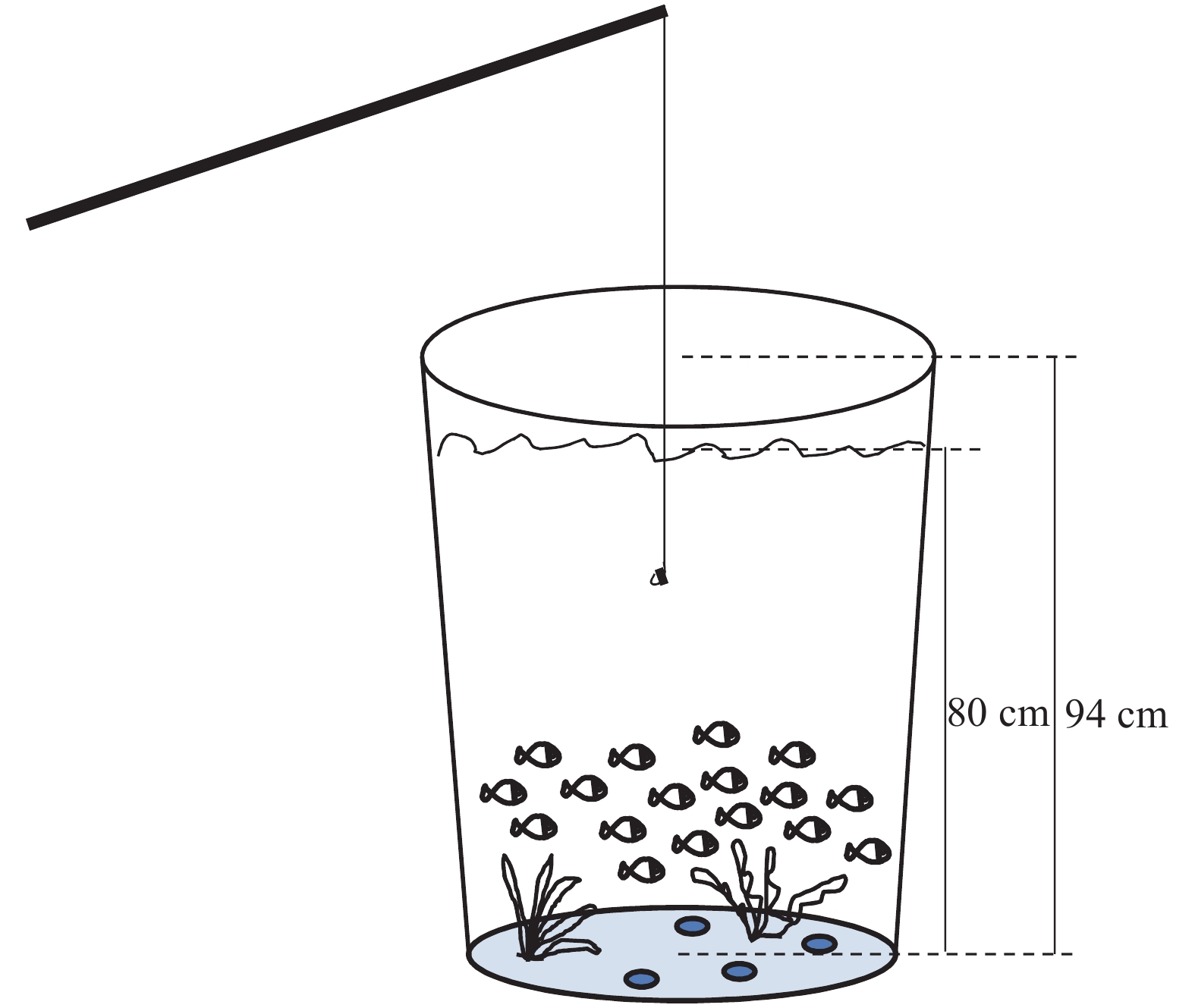
 下载:
下载:

